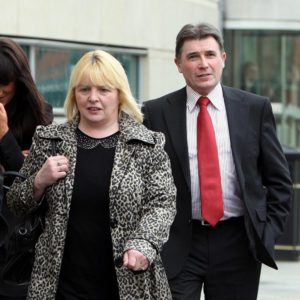
Dessie Grew, 37 anni, e Martin McCaughey, 23 anni, furono colpiti a morte nei dintorni di Loughgall dall’esercito inglese, che sparò loro 72 proiettili nel mese di ottobre 1990.
Il militare, che ha dato testimonianza al tribunale di Belfast protetto da una tenda, è stato identificato solo come “Soldato C”.
Karen Quinlivan, avvocato delle famiglie delle due vittime, ha contestato le affermazioni del soldato, che avrebbe sparato 19 colpi perché credeva di essere sotto attacco. Era emerso infatti che i due militanti repubblicani non avevano sparato alcun colpo. La Quinlivan ha detto: “Questo è un resoconto che avete costruito in modo da giustificare l’uso eccessivo della forza eccessiva avvenuto la notte in questione”.
Il Soldato C ha confermato che l’esercito britannico aveva messo sotto sorveglianza il riparo nei pressi di Loughgall perché c’era il sospetto che un veicolo rubato tenuto al suo interno fosse stato usato per azioni di terrorismo.
Ha confermato l’assenza di avvertimento da parte del commando della SAS prima di aprire il fuoco, ma ha respinto le accuse di aver fabbricato appositamente la sua testimonianza e ha spiegato di aver aperto il fuoco dopo aver visto dei lampi, che in seguito è emerso che erano stati causati dai proiettili sparati dai soldati.
In aula è stato riportato che il Soldato C aveva dichiarato di aver aperto il fuoco perché credeva che la sua vita e quelle degli altri soldati erano a rischio. Dopo che un commilitone ha iniziato a sparare ai due uomini, il Soldato C ha affermato: “Pensavo che ci fossero più uomini. Potevano nascondersi altre persone. Ho visto lampi che pensavo fossero provocati da armi da fuoco”.
L’inchiesta, entrata nel suo quinto giorno di lavoro, ha già ascoltato un medico che ha esaminato i morti e ha detto che giacevano nei pressi di armi da fuoco. L’inchiesta riguarda una delle molteplici operazioni delle forze di sicurezza definite “sparare-per-uccidere” (shoot-to-kill), che hanno suscitato polemiche ed una serie di indagini ufficiali.
L’ufficiale di comando al momento dell’imboscata della SAS a Loughgall, il Soldato K, ha negato l’esistenza di una politica simile, volta ad eliminare fisicamente i membri dei gruppi paramilitari.
L’inchiesta continua.
Soldier denies cover-up claims
Dessie Grew, 37, and Martin McCaughey, 23, died when troops fired 72 bullets at the pair near farm buildings in Co Armagh in October 1990.
The military witness, who gave evidence from behind a curtain at Laganside courts in Belfast, was identified only as Soldier C.
A barrister representing the men’s families, Karen Quinlivan, contested claims he fired 19 rounds because he believed he was under attack, though it later emerged the republicans did not shoot. Ms Quinlivan said: “That is an account that you have made up in order to justify the excessive force that you used on the night in question.”
Soldier C confirmed the troops had the mushroom shed near Loughgall under surveillance amid suspicions a stolen vehicle inside was to be used for terrorism.
He confirmed troops gave no warning before firing, but he rejected claims he had fabricated his account and said he had opened fire in response to flashes that later emerged to have been caused by bullets fired by the soldiers.
The jury heard Soldier C had claimed to have opened fire because he believed his life and those of the other troops were at risk. After a colleague started shooting at the two men, Soldier C said: “I thought there were more men. More men could be hiding. I seen flashes that I thought were muzzle flashes.”
The inquest, which is in its fifth day, has already heard from a doctor who examined the dead men and said they were lying near guns. The inquest is one of several so-called security force “shoot-to-kill” incidents which have sparked controversy and a series of official investigations.
The officer commanding at the time of the present matter, Soldier K, has denied there was a policy of shoot to kill.
The inquest continues.